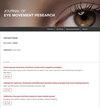使用眼动跟踪技术诊断神经系统变性患者的阅读问题时考虑视野异常情况
IF 1.3
4区 心理学
Q3 OPHTHALMOLOGY
引用次数: 0
摘要
最先进的眼动仪通过测量和解释人们阅读文本时的注视路径,为诊断阅读问题提供了宝贵的信息。我们的目标是研究视野缺陷如何影响阅读注视路径模式,以便将此类神经系统病变的影响明确纳入更全面的阅读诊断方法中。我们设计了一项横断面、非随机、试验性临床研究,其中包括 45 名患有各种神经系统疾病的患者和 30 名正常对照者。结果显示,使用眼动仪显示脑损伤和视野改变的患者需要更多的时间来完成文字阅读测试,这些患者的定点次数更多 (p < 0.001);定点时间更长 (p = 0.03);眼球移动次数更多 (p = 0.04)。我们的研究表明,患有神经系统疾病和视野改变并抱怨阅读困难的患者的眼球运动特征存在客观差异。这些发现应被视为偏差因素,值得进一步研究。本文章由计算机程序翻译,如有差异,请以英文原文为准。
Accounting for visual field abnormalities when using eye-tracking to diagnose reading problems in neurological degeneration
State-of-the-art eye trackers provide valuable information for diagnosing reading problems by measuring and interpreting people’s gaze paths as they read through text. Abnormal conditions such as visual field defects, however, can seriously confound most of today’s existing methods for interpreting reading gaze patterns.
Our objective was to research how visual field defects impact reading gaze path patterns, so the effects of such neurological pathologies can be explicitly incorporated into more comprehensive reading diagnosis methodologies. A cross-sectional, non-randomized, pilot clinical study including 45 patients with various neurologic disorders and 30 normal controls was designed. Participants underwent ophthalmologic/neuropsychologic and eye-tracker examinations using two reading tests of words and numbers.
The results showed that the use of the eye tracker showed that patients with brain damage and an altered visual field require more time to complete a reading-text test by fixating a greater number of times (p < 0.001); with longer fixations (p = 0.03); and a greater number of saccades in these patients (p = 0.04). Our study showed objective differences in eye movement characteristics in patients with neurological diseases and an altered visual field who complained of reading difficulties. These findings should be considered as a bias factor and deserve further investigation.
求助全文
通过发布文献求助,成功后即可免费获取论文全文。
去求助
来源期刊

Journal of Eye Movement Research
OPHTHALMOLOGY-
CiteScore
2.90
自引率
33.30%
发文量
10
审稿时长
10 weeks
期刊介绍:
The Journal of Eye Movement Research is an open-access, peer-reviewed scientific periodical devoted to all aspects of oculomotor functioning including methodology of eye recording, neurophysiological and cognitive models, attention, reading, as well as applications in neurology, ergonomy, media research and other areas,
 求助内容:
求助内容: 应助结果提醒方式:
应助结果提醒方式:


